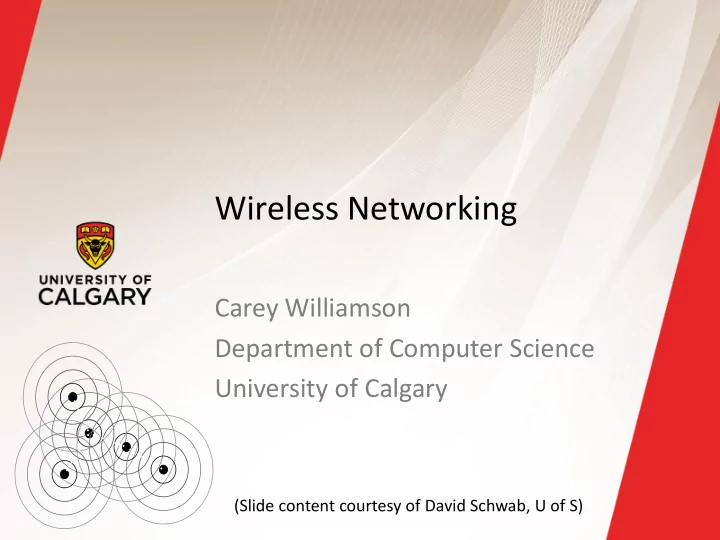

Wireless Networking Carey Williamson Department of Computer Science University of Calgary (Slide content courtesy of David Schwab, U of S)
What Is Wireless Networking? ▪ The use of infra-red or radio frequency signals to share information and resources between devices ▪ A hot computer industry buzzword: — Lots of advertising by companies and media — Wireless Broadband, 3G/4G/5G, LTE, Bluetooth ▪ Mobile Internet, Pervasive Computing, IoT, etc. — Ubiquitous — Global — Revolutionary
Two Popular 2.4 GHz Standards ▪ IEEE 802.11 ▪ Bluetooth — Fast (11b) — Slow — High power — Low power — Long range — Short range — Single-purpose — Flexible — Ethernet replacement — Cable replacement — Easily Available — “Vapourware” ▪ Apple Airport, iBook, G4 ▪ Anoto, Test cards, phone ▪ Cisco Aironet 350
IEEE 802.11 Family Tree: Historical Look IEEE 802.11 Working Group PHYS Layer MAC Layer Infra-Red (IR) 2.4 GHz (FHSS) 2.4 GHz (DSSS) 5 GHz (OFDM) 802.11 MAC 802.11 IR 802.11 FHSS 802.11 DSSS 802.11a 802.11e 1 / 2 Mbit/s 1 / 2 Mbit/s 1 / 2 Mbit/s 6 / 12 / 24 Mbit/s MAC Enhancements Optional 9/18/36/54 Mbit/s 802.11b Security High Data Rate Extension 5.5 / 11 Mbit/s QOS 802.11g Data Rates > 20 Mbit/s
Pros and Cons of 802.11b ▪ Pro: — High bandwidth (up to 11 Mbps) — Two modes of operation: infrastructure vs. ad hoc ▪ Con: — Incompatibility between old and new cards — Signal blocked by reinforced concrete or tinted glass — High channel BER can degrade performance (lots!) — No standard for hand-off between base stations — Some channel numbers overlap in spectrum — High power consumption in laptops
Multi-Hop Wireless Ad Hoc Networks ▪ Routing protocols used to improve wireless connections ▪ Infrastructure-free, dynamic ▪ True Peer-to-Peer routing ▪ Fault tolerant ▪ Examples: AODV, DSDV, TORA, DSR, ...
Bluetooth ▪ Think USB, not Ethernet ▪ Created by Ericsson ▪ PAN - Personal Area Network — 1-2 Mbps connections — 1600 hops per second FHSS — Includes synchronous, asynchronous, voice connections — Piconet routing ▪ Small, low-power, short-range, cheap, versatile radios ▪ Used as Internet connection, phone, or headset
Wireless Security Issues ▪ Wireless networks are “broadcast” networks ▪ Wireless sniffers ▪ IEEE 802.11: — ESSID – Extended Services Set ID — WEP – Wired Equivalent Privacy ▪ 40 bit RC4 (RSA) encryption ▪ Bluetooth Security — Rapid hop sequence — Short range — Encrypted transmissions
Wireless Mesh Networking ▪ An alternative to traditional ISPs and wired Internet ▪ A grassroots movement established in 1996 — 802.11 Wireless LAN cards — Roof mounted antennae — Free software (FreeBSD) ▪ Multi-hop routing, Internet connectivity ▪ Cheap nodes, and lots of them ▪ Public wireless mesh networks popular in many large cities, including San Francisco, Seattle, London, …
Future of Wireless ▪ Better mobility support ▪ Better security ▪ Wider selection ▪ Lower prices ▪ Less configuration required ▪ More end-user focus ▪ Better software ▪ Less visible ▪ More popular
Recommend
More recommend